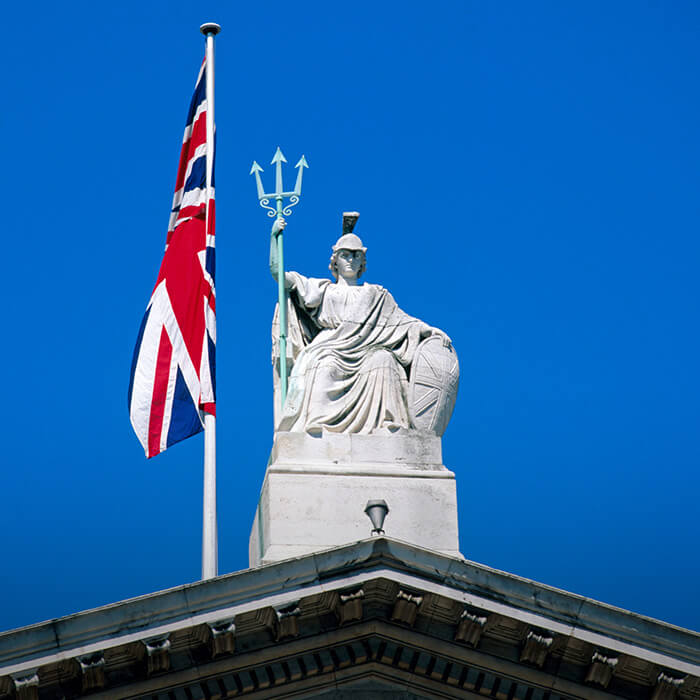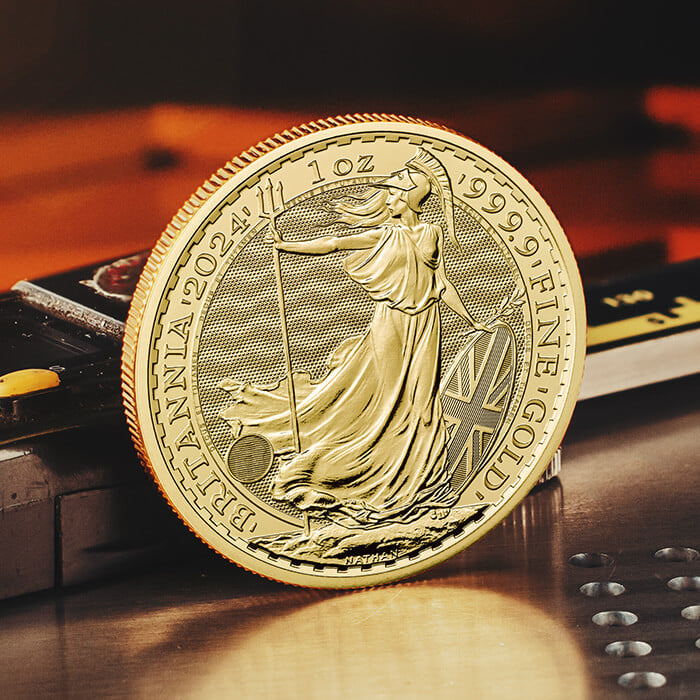![]()
Our new Britannia release comprises a collection of nine coins celebrating a true icon who has evolved through the ages. Instantly recognisable, she has gone through many fascinating guises in her long and enduring history and has appeared on a range of denominations.
The Romans were the first to portray the British Isles in female form on coins, depicting Britannia seated on a wall, or rocks, on a coin struck in the years before the emperor Hadrian visited Britain in AD 122. The Romans also personified other provinces, including Africa, Gallia and Dacia, as women on coins.
Following the decline of the Roman Empire, the use of Britannia’s image lapsed until the reign of Elizabeth I, when the mathematician and astrologer John Dee promoted the idea of a British empire based on maritime power. Published in 1577, the cover page of his book General and Rare Memorials Pertayning to the Perfect Arte of Navigation shows Britannia kneeling on the shore before Elizabeth I, portrayed seated on a ship, in an appeal to the queen to strengthen the navy.
During the seventeenth century, the Stuart monarchs were keen to position themselves as masters of the seas and saw the figure of Britannia as a way to bolster this image. Depicted on pattern farthings made in 1665 alongside a Latin inscription that translates as ‘I Claim the Four Seas’, Britannia also appeared on a medal struck in 1667 to mark the Peace of Breda. In a design by The Royal Mint’s engraver John Roettiers, the medal shows Britannia seated at the foot of cliffs, looking out to a fleet at sea and holding a spear and a shield.
![]()
Roettiers also designed the image of Britannia that featured on circulating coins in 1672, appearing on the reverse of the new copper halfpennies and farthings. His likeness of Britannia is said to closely resemble Frances Stewart, a lady-in-waiting to Queen Catherine who was pursued by the king, Charles II. Samuel Pepys described Stewart – known as ‘La Belle Stewart’ – as ‘the greatest beauty I ever saw’ in his diary. In 1694, the newly established Bank of England also chose to use the figure of Britannia for its seal and on banknotes.
The next major change came in 1797, with a design by Conrad Heinrich Küchler of the Soho Mint chosen for a new coin. A large quantity of copper pennies and twopence coins featuring Küchler’s design were produced and became known as ‘cartwheels’, due to their size and their distinctive rim. The image marked a more nautical Britannia, as it showed the icon holding a trident, rather than a spear, and surrounded by the sea.
During the reign of William IV, Britannia appeared on the silver groat (known as fourpence). Edward I originally introduced the groat but following the Restoration of 1660, it was infrequently minted for circulation. The MP Joseph Hume called for its return and Britannia appeared on the new silver groat issued in 1836. The coin was nicknamed the ‘Joey’ after Hume, a name which was later given by some to the threepence when the groat went out of circulation.
In 1860, during the reign of Queen Victoria, a smaller, thinner and more durable bronze coin replaced the old copper coinage. The Royal Mint’s engraver Leonard Charles Wyon designed the reverse image of Britannia and the coin is often known as the ‘bun penny’, due to the portrait of Queen Victoria in which her hair is in a bun, on the coin’s obverse, which was also designed by Wyon.
![]()
Wyon’s successor as engraver, George William De Saulles, was chosen to design a new Britannia for the reverse of the florin when Edward VII became the king in 1901. De Saulles’ Britannia was modelled on Susan Hicks-Beach, the 17-year-old daughter of the Chancellor of the Exchequer, with Britannia shown standing on the prow of a ship. The coin also featured De Saulles’ iconic portrait of the king on the obverse. Although De Saulles’ Britannia is today considered a classic design, it was not particularly popular at the time and its use ceased after 1911.
Following the death of George V in 1936, Britannia was reinterpreted again and pattern pennies featuring her image were made ahead of Edward VIII’s planned coronation in 1937. The design by Charles Walter Coombes was modelled at The Royal Mint and replicated Leonard Wyon’s 1860 version, with a lighthouse in the background. Following Edward VIII’s abdication, Coombes’ design was transferred to the coinage produced for George VI and appeared on the coinage of Her Majesty The Queen until decimalisation.
As the United Kingdom prepared for decimalisation, it was decided in 1968 that Britannia would not appear on the new coins, but this caused such a public outcry that questions were raised in the House of Commons and the decision was overturned. As a result, Britannia appeared on the new UK 50p coin issued in 1969. It was the world’s first seven-sided coin and featured Christopher Ironside’s iconic Britannia, holding a trident and an olive branch.
In 2008, Britannia disappeared from circulating coins but was reintroduced in 2015, when Antony Dufort reimagined her for the UK £2 coin. In 1987, the Chancellor of the Exchequer Nigel Lawson gave consent for a new £100 gold coin. The winning design was by the artist Philip Nathan and his seminal, standing Britannia has endured as the face of modern bullion. In 2021, The Royal Mint redefined security by adding four groundbreaking features and today, our Britannia bullion coin is the most visually secure coin in the world.
Discover Britannia

AN ANCIENT SYMBOL OF STRENGTH AND FORTITUDE
Explore Britannia's Origins
BRITANNIA AND LIBERTY
Read about the design
WHAT MAKES BRITANNIA BULLION COINS SECURE?
Find Out More